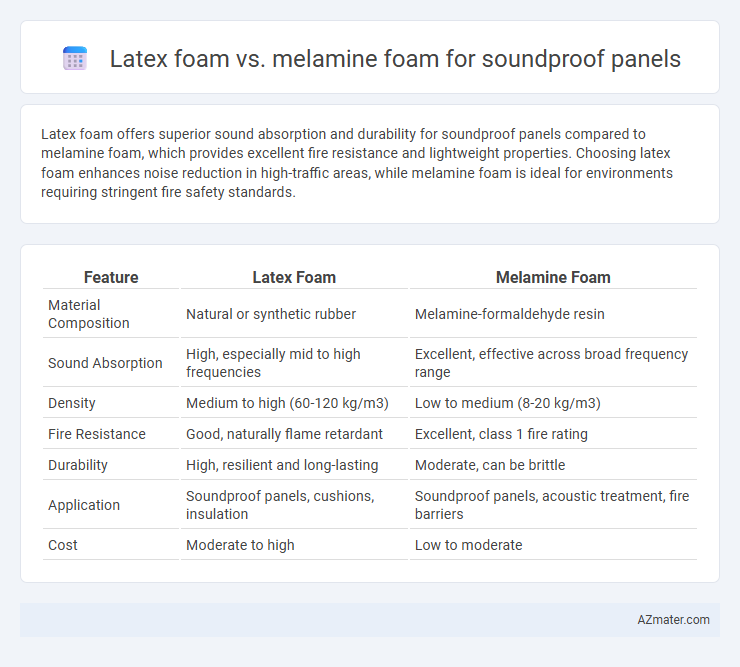Latex foam offers superior sound absorption and durability for soundproof panels compared to melamine foam, which provides excellent fire resistance and lightweight properties. Choosing latex foam enhances noise reduction in high-traffic areas, while melamine foam is ideal for environments requiring stringent fire safety standards.
Table of Comparison
| Feature | Latex Foam | Melamine Foam |
|---|---|---|
| Material Composition | Natural or synthetic rubber | Melamine-formaldehyde resin |
| Sound Absorption | High, especially mid to high frequencies | Excellent, effective across broad frequency range |
| Density | Medium to high (60-120 kg/m3) | Low to medium (8-20 kg/m3) |
| Fire Resistance | Good, naturally flame retardant | Excellent, class 1 fire rating |
| Durability | High, resilient and long-lasting | Moderate, can be brittle |
| Application | Soundproof panels, cushions, insulation | Soundproof panels, acoustic treatment, fire barriers |
| Cost | Moderate to high | Low to moderate |
Introduction to Soundproof Panel Materials
Latex foam offers excellent sound absorption due to its open-cell structure, making it effective for reducing echo and reverberation in soundproof panels. Melamine foam is known for its lightweight, fire-resistant properties and superior acoustic performance, especially in high-frequency noise attenuation. Both materials serve distinct purposes in soundproof panel construction, with latex foam providing comfort and breathability while melamine foam excels in thermal insulation and fire safety.
Overview of Latex Foam for Soundproofing
Latex foam for soundproof panels provides excellent acoustic insulation due to its open-cell structure, which efficiently absorbs sound waves across a broad frequency range. Its natural elasticity and durability enhance noise reduction performance while maintaining breathability and resistance to moisture and mold. Compared to melamine foam, latex foam offers superior comfort and resilience, making it a preferred choice in environments demanding both soundproofing and long-term material integrity.
Overview of Melamine Foam for Soundproofing
Melamine foam is a lightweight, open-cell material known for its effective sound absorption and thermal insulation properties, making it ideal for soundproof panels. Its porous structure allows it to trap and dissipate sound waves across a broad frequency range, reducing echo and noise in various environments. Compared to latex foam, melamine foam offers enhanced fire resistance and durability, often preferred in commercial and industrial acoustic treatments.
Acoustic Performance Comparison
Latex foam exhibits higher sound absorption coefficients in mid to high frequencies, typically ranging from 0.6 to 0.9 between 500 Hz and 4000 Hz, making it highly effective for reducing echo and reverberation in speech and music environments. Melamine foam, characterized by an open-cell structure, performs exceptionally well in absorbing high-frequency sounds above 1000 Hz, with sound absorption coefficients often exceeding 0.8, but it is less effective at attenuating low-frequency noise below 500 Hz. The choice between latex and melamine foam for soundproof panels depends on the targeting frequency range: latex foam is more versatile for broad-spectrum absorption including mid-frequencies, while melamine foam excels in lightweight, flame-retardant applications focusing on high-frequency noise control.
Durability and Longevity
Latex foam offers superior durability and longevity compared to melamine foam, maintaining its structural integrity and acoustic performance over extended periods under various environmental conditions. Melamine foam, while lightweight and effective for sound absorption, tends to degrade faster due to its brittle nature and lower resistance to moisture and physical wear. For soundproof panels requiring long-term stability and resilience, latex foam proves to be a more robust and enduring choice.
Fire Resistance Capabilities
Latex foam offers moderate fire resistance with self-extinguishing properties but can emit toxic smoke when burned, making it less ideal for high-risk fire environments. Melamine foam excels in fire safety, being inherently flame retardant, non-combustible, and producing minimal smoke, which enhances its suitability for soundproof panels in commercial and residential buildings. Its Class A fire rating and ability to withstand high temperatures without melting or dripping make melamine foam the preferred choice for rigorous fire resistance requirements.
Installation and Maintenance
Latex foam soundproof panels offer easy installation due to their flexible structure that conforms well to surfaces without requiring extensive mounting hardware, while melamine foam panels demand careful handling and adhesive application because of their rigid and brittle nature. Maintenance of latex foam panels is straightforward, involving occasional vacuuming to remove dust without degrading the material, whereas melamine foam panels need gentle cleaning to avoid crumbling or damage from harsh chemicals. The durability and resilience of latex foam make it more suitable for long-term use in environments requiring frequent panel adjustments or cleaning compared to the more delicate melamine foam.
Environmental Impact and Safety
Latex foam offers a sustainable option for soundproof panels, being biodegradable and derived from renewable natural rubber, thus reducing environmental impact compared to synthetic alternatives. Melamine foam, while effective in sound absorption, is chemically synthesized and non-biodegradable, potentially contributing to long-term environmental waste. In terms of safety, latex foam is hypoallergenic and resistant to mold and mildew, whereas melamine foam can release irritant dust particles during installation, requiring proper protective measures.
Cost-Effectiveness Analysis
Latex foam generally offers higher durability and better sound absorption coefficients (NRC values around 0.75 to 0.85) compared to melamine foam, which typically ranges between 0.60 and 0.80 but comes at a significantly lower initial cost. Melamine foam's lightweight and open-cell structure make it more affordable and easier to install for large-scale projects, though it may degrade faster under heavy use, potentially increasing replacement expenses over time. Evaluating long-term cost-effectiveness involves balancing latex foam's superior acoustic performance and longevity against melamine foam's upfront savings and suitability for temporary or budget-conscious soundproofing applications.
Conclusion: Choosing the Right Foam for Your Needs
Latex foam offers superior durability, breathability, and natural sound absorption, making it ideal for environments requiring comfort and long-term use. Melamine foam excels in high-frequency sound attenuation and fire resistance, suited for industrial or commercial soundproofing applications. Selecting the right foam depends on balancing acoustic performance, environmental factors, and budget constraints to meet specific soundproofing requirements.

Infographic: Latex foam vs Melamine foam for Soundproof panel
 azmater.com
azmater.com